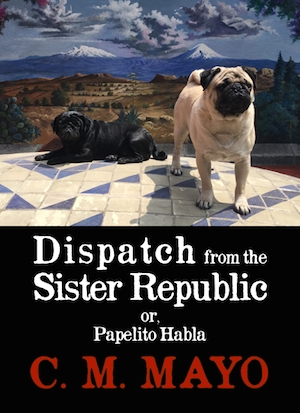
ON THE RELACION OF CABEZA DE VACA
An
excerpt from the forthcoming long essay
about the Mexican literary landscape and the power of the book,
"Dispatch
from the Sister Republic or, Papelito Habla"
Originally published
in Scoundrel
Time
May 20, 2017
C.M. MAYO
. |
 Such
is my axis in the Theater of Space-Time: On
this mid-January day of 2017, Donald J. Trump has just been sworn
in as the 45th President of United States, to the uneasy consternation
of every Mexican I know, whether they consider themselves on
the political left, center, or right. Mexico City's smog feels
more miasmic for the resentful confusion, a sense of a new knife
descending on old scars, impending chaos. Such
is my axis in the Theater of Space-Time: On
this mid-January day of 2017, Donald J. Trump has just been sworn
in as the 45th President of United States, to the uneasy consternation
of every Mexican I know, whether they consider themselves on
the political left, center, or right. Mexico City's smog feels
more miasmic for the resentful confusion, a sense of a new knife
descending on old scars, impending chaos.
From my desk here in the southern suburb of Coyoacán,
beyond my neighbors' flat-roofs and water tanks, through a break
in the clutter of jacarandas and shaggy-headed palms, I can sometimes
glimpse the lava dome known as the Ajusco. I treasure my view—this
dinosaur's spine—not because it is spectacular, but for
the chance, rare outside of a skyscraper, to rest my gaze on
such a luxury of distance.
Today I can make out only a pale blear. But after wind sweeps
the sky, many a time I have seen the Ajusco in crispest of outlines,
glowing an orange-ashy-rose worthy of Maxfield Parrish, and all
dusted with snow.
On my desk sits another luxury of distance, the English translation
of the 1542 Relación (report) by the conquistador
whom I have come to think of, fondly, no disrespect intended,
as Mr. A. Cow Head—because that was his name: Álvar
Nuñez Cabeza de Vaca.
A would-be conquistador of Florida, Cabeza de Vaca was serving
as treasurer for the expedition that set out from the island
of Cuba in 1528—this was only seven years after the conquest
of Mexico. They shipwrecked. Most of the men drowned, starved,
perished of exposure, or were, at one point or another in their
hideous odyssey out of Florida, killed by Indians. In what is
today an area of East Texas, Cabeza de Vaca was enslaved for
eight brutal years. When he finally escaped, he joined with the
remaining survivors, two Spaniards and a Moor, and led them,
wandering in what he hoped was a direction that would take them
to the outposts of the Spanish colony.
From the details of his description, we know that Cabeza de Vaca
reached La Junta, where the Río Conchos and the Río
Grande flow together on what is now the U.S.-Mexico border at
Presidio, Texas and Ojinaga, Chihuahua. Everyone who has written
about Cabeza de Vaca has his or her pet theory about the rest
of his itinerary, but all agree that he zigzagged west across
the pitiless expanse of what are today portions of northern Coahuila,
Chihuahua, and Texas.
Upon his rescue in 1536, Cabeza de Vaca was brought here, to
Mexico City-Tenochtitlán, where the Viceroy and Hernán
Cortés, now the Marqués del Valle, received the
Spanish survivors warmly. It was as if, given up for dead, they
had returned from the moon. As translated by Rolena Adorno and
Patrick Charles Pautz, writes Cabeza de Vaca: "[T]hey gave
us clothes to wear and offered everything they had, and on the
day of Saint James there were fiestas and juegos de cañas
and bullfights."
Cabeza de Vaca stayed in Mexico City-Tenochtitlán for
two months. More likely than not, he would have made the day's
journey south to Coyoacán. Had he walked, or perhaps,
with more dignity, ridden a horse over the patch of, presumably,
cornfields where my house now stands—and he may well have—his
view of the Ajusco would have been, unlike mine, spectacular.
And the air, for him, so fresh yet musky with the perfume of
wood fires and gardens.
|
*
|
Massive as the Ajusco may be, it is but one bead in the necklace of
volcanoes around Mexico City. The sheared-off cone of Xitle (pronounced
sheet-leh), boiled up from beneath the Ajusco's north-facing
slope into a fist of lava some 1,700 years ago-culminating in
the eruption that destroyed Cuicuilco—the Pompeii of the
New World—vomiting down a nearly 30-square-mile-wide bed
of soot-black lava. This is known to us as El Pedregal, the stony
place.
I do not know what the Aztecs called the Pedregal. For what it's
worth, the Spanish-Nahuátl dictionary I Googled up online
translates pedegral as tetlan. When Xitle blew,
the ancestors of the Aztecs would have been hunting and gathering
in lands possibly north of present-day Wyoming—assuming,
as linguistic evidence suggests, that the Aztecs descended from
the same stock as the Shoshone and Comanche.
In Frida Kahlo's lifetime much of this remained a wasteland,
as can be seen in her 1952 painting hanging in Coyoacán's
Casa Azul, "Paisaje del Pedregal." (Landscape of the
Pedregral). Kahlo's husband, the great muralist Diego Rivera,
understood that the Pedegral was destined, like Lake Texcoco,
to disappear beneath Mexico City. When he donated his personal
museum of prehispanic art, housed in his indigenous- and Frank
Lloyd Wright-inspired Anahuacalli (Nahuátl for House of
the Valley of Mexico), which was built in Coyoacán on
the outer reach of the Pedregal, Rivera stipulated that the surrounding
acreage be left in its original state. And it has been. With
the press of Mexico City all around, Anahuacalli's Espacio Ecológico
feels larger than it is. Here and there, shivering the breeze,
trees perch on the rocks. And cacti, tufts of grass, many mice
and ants. Flies, bees, butterflies, and above the drone of traffic,
birdsong.
When I arrived in Mexico City the mid-1980's, most of the Pedregal
was long built over with the Universidad Nacional Autónoma
de México, housing developments, including an upscale
suburb of avant-garde mansions, shopping malls, churches, schools,
parking lots— although the ring road, or Periférico,
licks past the excavated base of the great circular pyramid of
Cuicuilco. Then as now, if you know where to look, here and there,
whether in the Espacio Ecológico or on the extensive grounds
of the university, or some unlikely spot, say, between a sidewalk
and the front wall of a house, you might spy a wild swirl or
pocked buttress of Xitle's black spew.
Cabeza de Vaca says nothing about the Pedregal in his Relación.
But it would have been impossible for him to have missed it.
It could be seen from many hilltops, rooftops and miradors, all
across the valley, that sun-baked and rattlenake-infested Stygian
immensity.
So much is missing from his Relación. But I must,
as must we all, be grateful that Cabeza de Vaca troubled to write
it, and as generously as he did, and that it had the fortune
to be granted a royal license to be printed, and that, squeezed
through the bottlenecks of centuries, it survives—and not
only behind the bolted and fireproof doors of Special Collections,
but in easy-to-find paperback editions of all kinds, including
translations, such as this one here, on my desk, published by
the University of Nebraska Press in 2003, The Narrative of
Cabeza de Vaca. Surely the author would have been astounded
to know that this reader would find this edition in a bookshop
in Marfa, Texas, then carry it home in a suitcase—stuffed
into the belly of a machine that, with a ferocious thundering,
soared above the clouds to Mexico City.
And you, privileged reader, may view a facsimile of the stupendously
rare second edition of 1555 for free, courtesy of the Southwestern
Writers Collection at the Texas State University San Marcos,
at this link:
http://alkek.library.txstate.edu/swwc/cdv/about/index.html
|
*
|
Unique, larded with wonders, and as terrible a tale as it tells,
like all books, Cabeza de Vaca's Relación is a
magical object.
I am not talking about "magic" as delight, or mere
entertainment, tricks with a wand and silk bag of whatsits, or
say, Harry Potter's rock-and-roll ride on a cinematic broomstick.
I mean real magic—to quote Dion Fortune, a star of the British
occultist firmament: "the art and science of causing change
in consciousness in accordance with will."
But you already know that this is precisely what a book can do.
You also know, although it is rarely put this way, that books
enable us to catch and hurl packages of thought from a consciousness
at one axis of space-time to multiple others.
"Ca quemaca ca nehoatl." Yes, it is me, says
Moctezuma in the Florentine Codex.
Is that not magic?
And how can you not be haunted by this deeper, amber voice:
"I walked lost and naked through many very strange lands."
So says Mr. A. Cow Head to you in his Relación
that, as I write these lines, is but 25 years from its 500th
anniversary—half a millennium on this earth. Wherever and
whenever you read this, that is to say, wherever and whenever
you direct your eyes, to absorb into your consciousness these
glyphs, these sigils we call, ho hum, "writing," his
words bounce to life in your mind.
Papelito habla, the little piece of paper speaks, said
some of the awe-struck indigenous.
Papelito habla, say the Mexicans today, usually sardonically,
in reference to a contract.
|
This is excerpt is from a longer
essay about the Mexican literary landscape and the power of the
book,
"Dispatch from the Sister
Republic or, Papelito Habla."

|
 |
 |
|
|
|
|



